Calcineurin in reactive astrocytes plays a key role in the interplay between proinflammatory and anti-inflammatory signals
- PMID: 17699657
- PMCID: PMC6672188
- DOI: 10.1523/JNEUROSCI.1002-07.2007
Calcineurin in reactive astrocytes plays a key role in the interplay between proinflammatory and anti-inflammatory signals
Abstract
Maladaptive inflammation is a major suspect in progressive neurodegeneration, but the underlying mechanisms are difficult to envisage in part because reactive glial cells at lesion sites secrete both proinflammatory and anti-inflammatory mediators. We now report that astrocytes modulate neuronal resilience to inflammatory insults through the phosphatase calcineurin. In quiescent astrocytes, inflammatory mediators such as tumor necrosis factor-alpha (TNF-alpha) recruits calcineurin to stimulate a canonical inflammatory pathway involving the transcription factors nuclear factor kappaB (NFkappaB) and nuclear factor of activated T-cells (NFAT). However, in reactive astrocytes, local anti-inflammatory mediators such as insulin-like growth factor I also recruit calcineurin but, in this case, to inhibit NFkappaB/NFAT. Proof of concept experiments in vitro showed that expression of constitutively active calcineurin in astrocytes abrogated the inflammatory response after TNF-alpha or endotoxins and markedly enhanced neuronal survival. Furthermore, regulated expression of constitutively active calcineurin in astrocytes markedly reduced inflammatory injury in transgenic mice, in a calcineurin-dependent manner. These results suggest that calcineurin forms part of a molecular pathway whereby reactive astrocytes determine the outcome of the neuroinflammatory process by directing it toward either its resolution or its progression.
Figures
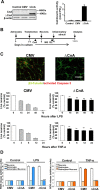
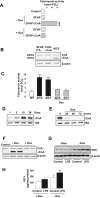
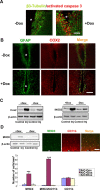
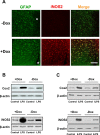
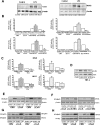
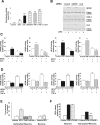

Similar articles
-
Interleukin-1beta-dependent signaling between astrocytes and neurons depends critically on astrocytic calcineurin/NFAT activity.J Biol Chem. 2008 Aug 8;283(32):21953-64. doi: 10.1074/jbc.M800148200. Epub 2008 Jun 9. J Biol Chem. 2008. PMID: 18541537 Free PMC article.
-
Regulation of the phosphatase calcineurin by insulin-like growth factor I unveils a key role of astrocytes in Alzheimer's pathology.Mol Psychiatry. 2012 Jul;17(7):705-18. doi: 10.1038/mp.2011.128. Epub 2011 Oct 18. Mol Psychiatry. 2012. PMID: 22005929
-
Insulin-like growth factor-I stimulates dephosphorylation of ikappa B through the serine phosphatase calcineurin (protein phosphatase 2B).J Biol Chem. 2000 Dec 8;275(49):38620-5. doi: 10.1074/jbc.M004531200. J Biol Chem. 2000. PMID: 10973957
-
The anti-inflammatory role of extranuclear apurinic/apyrimidinic endonuclease 1/redox effector factor-1 in reactive astrocytes.Mol Brain. 2016 Dec 16;9(1):99. doi: 10.1186/s13041-016-0280-9. Mol Brain. 2016. PMID: 27986089 Free PMC article.
-
The role of TNF-alpha and its receptors in the production of Src-suppressed C kinase substrate by rat primary type-2 astrocytes.Brain Res. 2007 Dec 12;1184:28-37. doi: 10.1016/j.brainres.2007.09.082. Epub 2007 Oct 10. Brain Res. 2007. PMID: 17980351
Cited by
-
Involvement of SRC-suppressed C kinase substrate in neuronal death caused by the lipopolysaccharide-induced reactive astrogliosis.Inflammation. 2010 Dec;33(6):359-73. doi: 10.1007/s10753-010-9194-3. Inflammation. 2010. PMID: 20204485
-
Axonal Protection by Tacrolimus with Inhibition of NFATc1 in TNF-Induced Optic Nerve Degeneration.Neurochem Res. 2019 Jul;44(7):1726-1735. doi: 10.1007/s11064-019-02804-6. Epub 2019 May 13. Neurochem Res. 2019. PMID: 31087207 Free PMC article.
-
Interleukin-1beta-dependent signaling between astrocytes and neurons depends critically on astrocytic calcineurin/NFAT activity.J Biol Chem. 2008 Aug 8;283(32):21953-64. doi: 10.1074/jbc.M800148200. Epub 2008 Jun 9. J Biol Chem. 2008. PMID: 18541537 Free PMC article.
-
The signaling landscape of insulin-like growth factor 1.J Biol Chem. 2025 Jan;301(1):108047. doi: 10.1016/j.jbc.2024.108047. Epub 2024 Dec 3. J Biol Chem. 2025. PMID: 39638246 Free PMC article. Review.
-
Targeting CaN/NFAT in Alzheimer's brain degeneration.Front Immunol. 2023 Nov 23;14:1281882. doi: 10.3389/fimmu.2023.1281882. eCollection 2023. Front Immunol. 2023. PMID: 38077352 Free PMC article. Review.
References
-
- Abbasi S, Lee JD, Su B, Chen X, Alcon JL, Yang J, Kellems RE, Xia Y. Protein kinase-mediated regulation of calcineurin through the phosphorylation of modulatory calcineurin-interacting protein 1. J Biol Chem. 2006;281:7717–7726. - PubMed
-
- Alfieri C, Evans-Anderson H, Yutzey K. Developmental regulation of the mouse IGF-I exon 1 promoter region by calcineurin activation of NFAT in skeletal muscle. Am J Physiol Cell Physiol. 2007;292:C1887–C1894. - PubMed
-
- Avni O, Lee D, Macian F, Szabo SJ, Glimcher LH, Rao A. T(H) cell differentiation is accompanied by dynamic changes in histone acetylation of cytokine genes. Nat Immunol. 2002;3:643–651. - PubMed
-
- Bailey ST, Ghosh S. “PPAR”ting ways with inflammation. Nat Immunol. 2005;6:966–967. - PubMed
-
- Beilharz EJ, Russo VC, Butler G, Baker NL, Connor B, Sirimanne ES, Dragunow M, Werther GA, Gluckman PD, Williams CE, Scheepens A. Co-ordinated and cellular specific induction of the components of the IGF/IGFBP axis in the rat brain following hypoxic-ischemic injury. Brain Res Mol Brain Res. 1998;59:119–134. - PubMed
Publication types
MeSH terms
Substances
LinkOut - more resources
Full Text Sources
Other Literature Sources
Molecular Biology Databases
